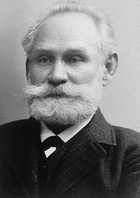| Magazine Home I Links I Contact Us |
|
Home |
Pavlov’s Dogs
The Russian physiologist Ivan Pavlov performed the first experiments with classical conditioning. As a young man, Pavlov had incredible energy, and he directed almost all of it toward science. His indifference to earthly concerns was legendary. At one time he and his wife were living in poverty, unable to pay their bills. To help him out, his students took up a collection and asked him to give a lecture series. He gave the speeches but used the money to buy lab animals instead of necessities for the family. When Pavlov began working with dogs, he was not studying behavior; he was investigating digestion. By putting meat powder in a dog’s mouth, he could elicit salivation and collect the saliva in a tube. Pavlov soon noticed, however, that the dog started to salivate before he offered it the meat powder — first when the dog saw the bowl, then when he heard Pavlov open the door. To learn more about this strange phenomenon, Pavlov began using a clicking metronome as a ‘conditional stimulus’. Immediately following this sound, he placed food in the dog’s mouth. After doing this several times, he noticed that the dog began to salivate as soon as it heard the metronome. These observations led Pavlov to a turning point in his career. He did not know whether to continue his studies of digestion or to begin investigating how the dog’s salivary gland “learns”. Fortunately for psychology, Pavlov chose to study conditioning. The typical procedure for inducing classical conditioning involves presentations of a neutral stimulus along with a stimulus of some significance, the “unconditional stimulus.” The neutral stimulus could be any event that does not result in an overt behavioral response from the organism under investigation. Conversely, presentation of the significant stimulus necessarily evokes an innate, never reflexive, response. Pavlov called these the unconditional stimulus (US) and unconditional response (UR), respectively. If the neutral stimulus is presented along with the unconditional stimulus, it would become a conditional stimulus (CS). Pavlov used the term conditional because he wanted to emphasize that learning required a dependent or conditional relationship between CS and US. If the CS and US always occur together and never alone, this perfect dependent relationship or pairing, causes the two stimuli to become associated and the organism produces a behavioral response to the CS. Pavlov called this the conditional response (CR). Pavlov’s research on conditional reflexes greatly influenced not only science, but also popular culture. The phrase “Pavlov’s dog” is often used to describe someone who merely reacts to a situation rather than using critical thinking. Pavlovian conditioning was a major theme in Aldous Huxley’s dystopian novel, Brave New World, and also to a large degree in Thomas Pynchon’s Gravity's Rainbow. |
| Home A B C D E F G H I J K L M N O P Q R S T U V W X Y Z |